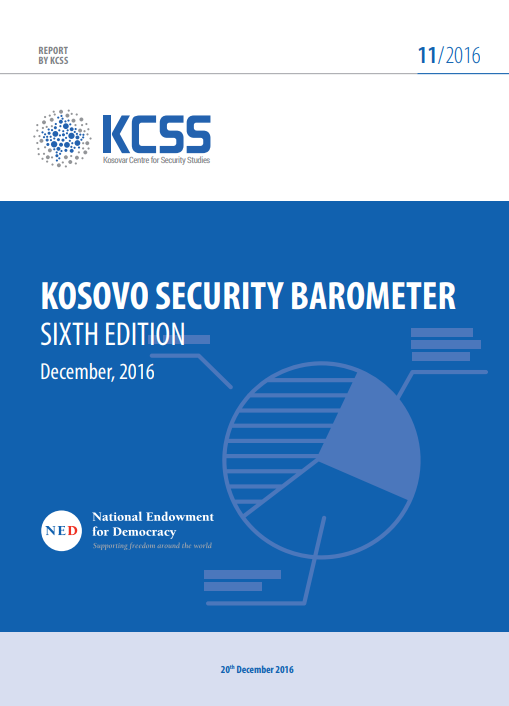21/12/2016

The Kosovo Security Barometer (KSB) is a specific programme of Kosovar Centre for Security Studies (KCSS) designed to serve as an annual publication. The primary focus of the KSB is to measure the public opinion perceptions towards security and justice institutions. It also measures the public perception on the internal and external security threats to Kosovo. The KSB marks one of the largest and rather first initiatives designed, implemented, and communicated by a local think tank in Kosovo. KCSS has no political constraints in communicating the findings and messages. Finally, the KSB is unique for its methodological approach, such as the unique tailoring of the quantitative and qualitative methods aiming to offer realistic results on public perceptions towards security-related issues.
The Sixth Edition of the KSB provides a summary of citizens’ trust towards security and justice institutions. It measured with particular focus the public perception towards internal and external safety and security-related concerns as well as issues pertaining to the future of the KSF and the international security presence in Kosovo.
Kosovo Security Barometer: Sixth Edition 7
Answers to the KSB questionnaires were collected through face-to-face interviews conducted around Kosovo. Most of the questions were close-ended in the form of five-point Likert scales. Few questions were open-ended allowing respondents the opportunity to provide their opinions without predefined options. The sampling, piloting, and interviewing were conducted by the KCSS team consisted of 27 field researchers. The national sample from which the research was drawn featured 1,093 households, following a representative sample of the population above 18 years old in Kosovo. The ethnic breakdown of the interviewed respondents was as follow: 86.9 percent K-Albanian, 7.0 percent K-Serbian, and 6.1 percent involved other communities (1.4 percent Turks, 0.6 percent Bosnian, 0,9 percent Roma, Ashkali, Egyptians and the rest includes gorans, Croats, and Montenegrins).
The sample frame was based upon telephone code areas, and, as such included the following 7 regions: Ferizaj, gjakova, gjilan, Mitrovica, Peja, Prishtina and Prizren. The first stage of geographical clustering was based on the 2011 Kosovo Census Report, while the second stage involved clustering samples by the respective municipal areas with a stratified rural/urban sample as per the number of households. The last stage followed a random sampling method using the nearest ‘birthday method’. Random sampling ensures that each resident in Kosovo has an equal probability of being chosen for an interview. given the the sample used for this study, the results of the survey project the mirror image of trends in attitudes and perceptions amongst the entire adult population of Kosovo in general. The margin of error is 3 percent with a confidence interval of 95 percent.
This project is supported by National Endowment for Democracy (NED).